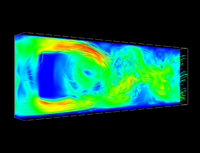Dominic Röhm
PhD student
| Office: | 16b (ground floor) |
|---|---|
| Fax: | +49 711 685-63658 |
| Email: | Dominic.Roehm _at_ icp.uni-stuttgart.de |
| Address: | Dominic Röhm Institute for Computational Physics Universität Stuttgart Allmandring 3 70569 Stuttgart Germany |
Research interests
Investigation of the heterogeneous nucleation, i.e. the early stage of crystal growth, in a colloidal model system near a wall by Molecular Dynamics computer simulations. My focus is on the influence of the hydrodynamic interaction, which is often neglected, since nucleation is considered as a quasi-static process.
However, recent experiments have shown, that the kind of thermalization of the sample has a drastic influence on the nucleation rate. The rate decreases by an order of magnitude, if the sample is molten by a turbulent flow rather than a laminar flow. In our simulations, hydrodynamic interactions are incorporated by coupling the particles to a lattice fluid representing the solvent.
[[
Since the computation of the hydrodynamic interaction is still orders of magnitude more expensive than classical interactions, our MD simulation software ESPResSo employs GPUs for the calculation of the lattice fluid, which was realized during my diploma thesis. By this, we can investigate systems, that previously required a small computer cluster, using a single GPU. By using a cluster equipped with GPUs, we want to use this speedup to systematically investigate the influence of hydrodynamics on the heterogeneous nucleation. Futhermore, I am working on a P3M GPU code for electrostatic interactions.
Diploma Thesis
Lattice-Boltzmann-Simulations on GPUs
In coarse-grained Molecular dynamics (MD) simulations of large macromolecules, the number of solvent molecules is normally so large that most of the computation time is spent on the solvent. For this reason one is interested in replacing the solvent by a lattice fluid using the Lattice-Boltzmann (LB) method. The LB method is well known and on large length and timescales it leads to a hydrodynamic flow field that satisfies the Navier-Stokes equation. If the lattice fluid should be coupled to a conventional MD simulation of the coarse-grained particles, it is necessary to thermalize the fluid. While the MD particles are easily coupled via friction terms to the fluid, the correct thermalization of the lattice fluid requires to switch into mode space, which makes thermalized LB more complex and computationally expensive.
However, the LB method is particularly well suited for the highly parallel architecture of graphics processors (GPUs). I am working on a fully thermalized GPU-LB implementation which is coupled to a MD that is running on a conventional CPU using the simulation package ESPResSo [1]. This implementation is on a single NVIDIA GTX480 or C2050 about 50 times faster than on a recent INTEL XEON E5620 quadcore, therefore replacing a full compute rack by a single desktop PC with a highend graphics card. Furthermore, due to communication overhead problems of the LB CPU code, the performance of a single NVIDIA Tesla C2050 can not achieved. Performance measurements using a AMD Opteron CPU cluster (1.9GHz) showed, that even to 96 CPU nodes are up to 12 times slower then a single GPU.
Publications
Curriculum vitae
Scientific education
- May. 2011 - ... Doctorate studies at Institute for Computational Physics (University of Stuttgart)
- Aug. 2011 Win of the NVIDIA Best Program Award, a CUDA competition held at the 20th International Conference on Discrete Simulation of Fluid Dynamics 2011, Fargo, USA.
- May. 2011 Diploma in Physics at University of Stuttgart
 Diplomarbeit (2.19 MB)
Diplomarbeit (2.19 MB)
- Oct. 2005 - May. 2011 Studies of Physics at the University of Stuttgart


